MGT5DPP: L&D Program Proposal for Nurses at Emerald Aged Care
VerifiedAdded on 2023/03/31
|11
|2244
|181
Case Study
AI Summary
This case study addresses the need for a learning and development program for nurses at Emerald Aged Care, an organization experiencing a growing demand for medical facilities within its aged care setting. The proposal outlines a comprehensive plan to address the nurses' lack of experience by implementing the ADDIE model (Analysis, Design, Development, Implementation, and Evaluation) and the 70:20:10 learning model, focusing on practical experience, developmental relationships, and formal training. Furthermore, the People-Based Leadership model is suggested to foster leadership qualities and career advancement among the nurses, emphasizing teamwork, support, and encouragement. The program aims to equip nurses with the necessary skills and leadership capabilities to effectively meet the needs of the residents and contribute to the organization's success.
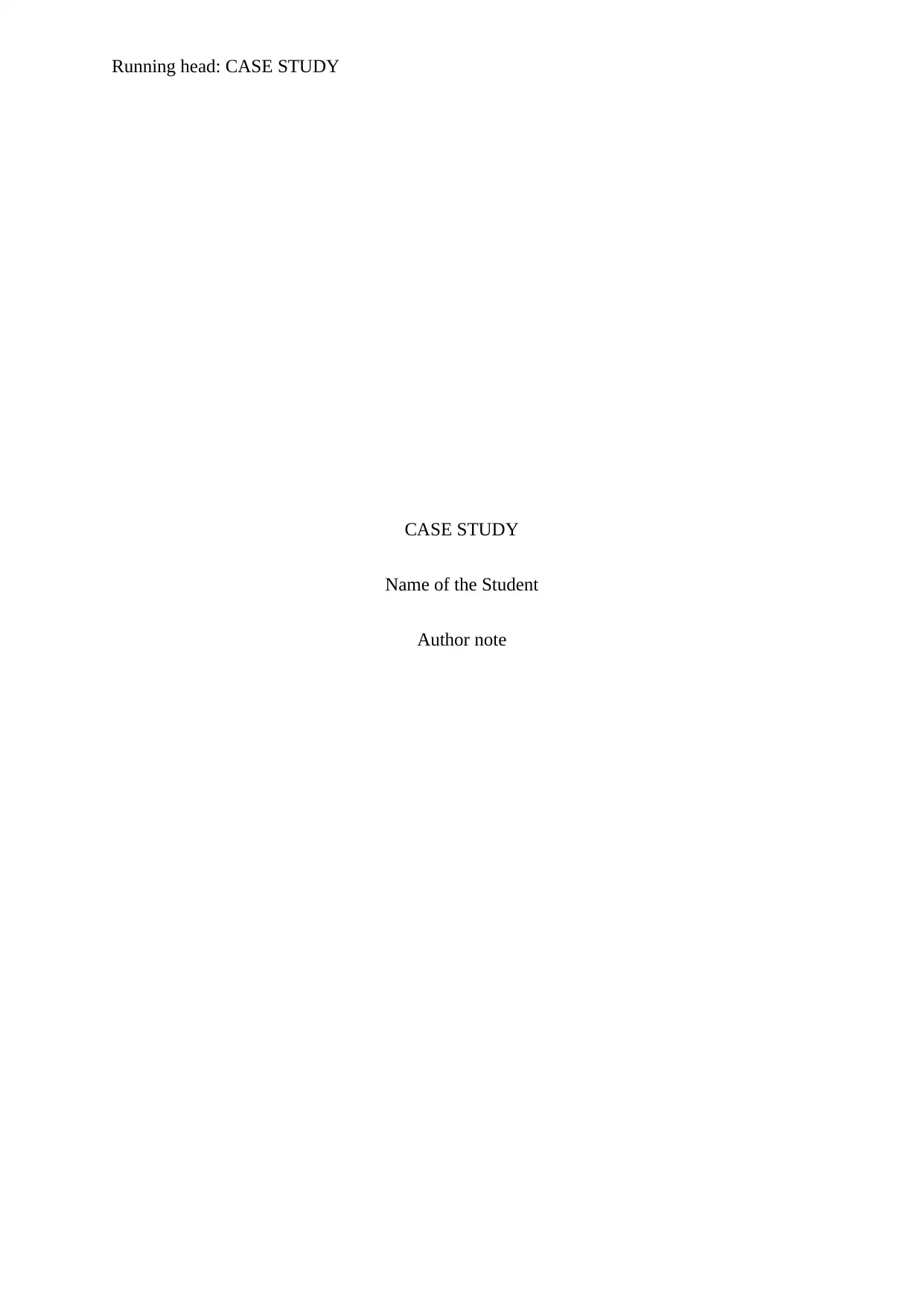
Running head: CASE STUDY
CASE STUDY
Name of the Student
Author note
CASE STUDY
Name of the Student
Author note
Paraphrase This Document
Need a fresh take? Get an instant paraphrase of this document with our AI Paraphraser
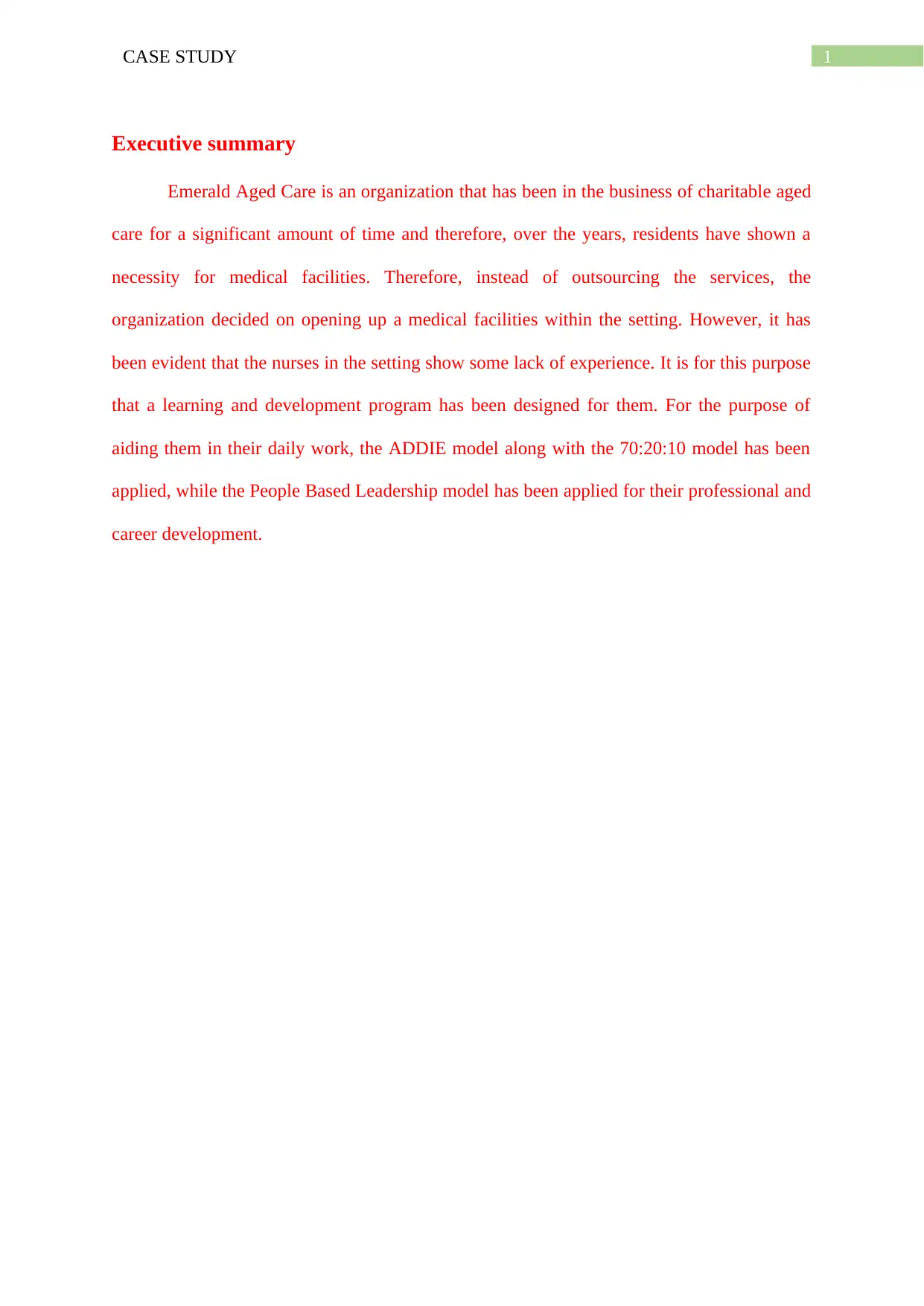
1CASE STUDY
Executive summary
Emerald Aged Care is an organization that has been in the business of charitable aged
care for a significant amount of time and therefore, over the years, residents have shown a
necessity for medical facilities. Therefore, instead of outsourcing the services, the
organization decided on opening up a medical facilities within the setting. However, it has
been evident that the nurses in the setting show some lack of experience. It is for this purpose
that a learning and development program has been designed for them. For the purpose of
aiding them in their daily work, the ADDIE model along with the 70:20:10 model has been
applied, while the People Based Leadership model has been applied for their professional and
career development.
Executive summary
Emerald Aged Care is an organization that has been in the business of charitable aged
care for a significant amount of time and therefore, over the years, residents have shown a
necessity for medical facilities. Therefore, instead of outsourcing the services, the
organization decided on opening up a medical facilities within the setting. However, it has
been evident that the nurses in the setting show some lack of experience. It is for this purpose
that a learning and development program has been designed for them. For the purpose of
aiding them in their daily work, the ADDIE model along with the 70:20:10 model has been
applied, while the People Based Leadership model has been applied for their professional and
career development.
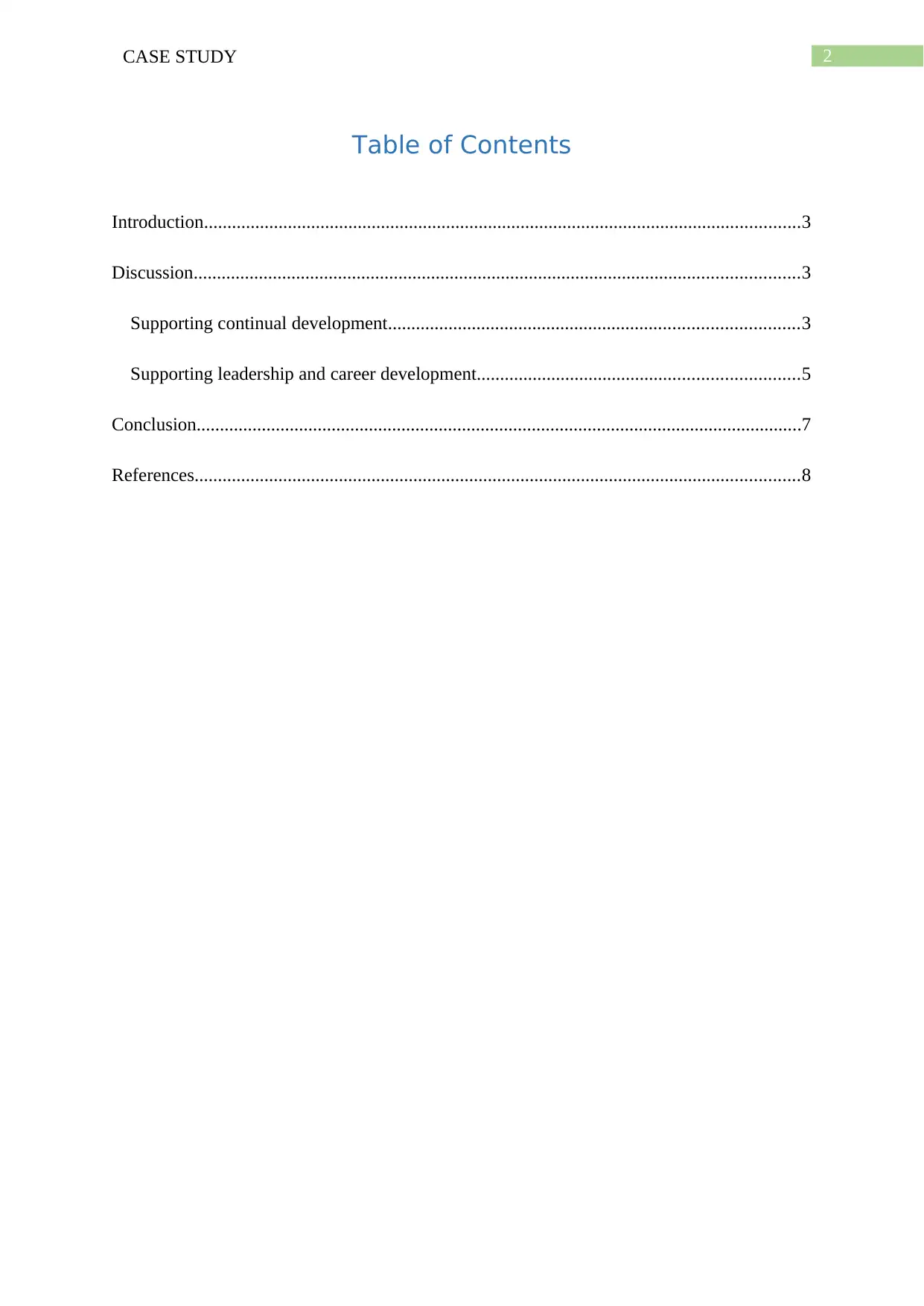
2CASE STUDY
Table of Contents
Introduction................................................................................................................................3
Discussion..................................................................................................................................3
Supporting continual development........................................................................................3
Supporting leadership and career development.....................................................................5
Conclusion..................................................................................................................................7
References..................................................................................................................................8
Table of Contents
Introduction................................................................................................................................3
Discussion..................................................................................................................................3
Supporting continual development........................................................................................3
Supporting leadership and career development.....................................................................5
Conclusion..................................................................................................................................7
References..................................................................................................................................8
⊘ This is a preview!⊘
Do you want full access?
Subscribe today to unlock all pages.

Trusted by 1+ million students worldwide
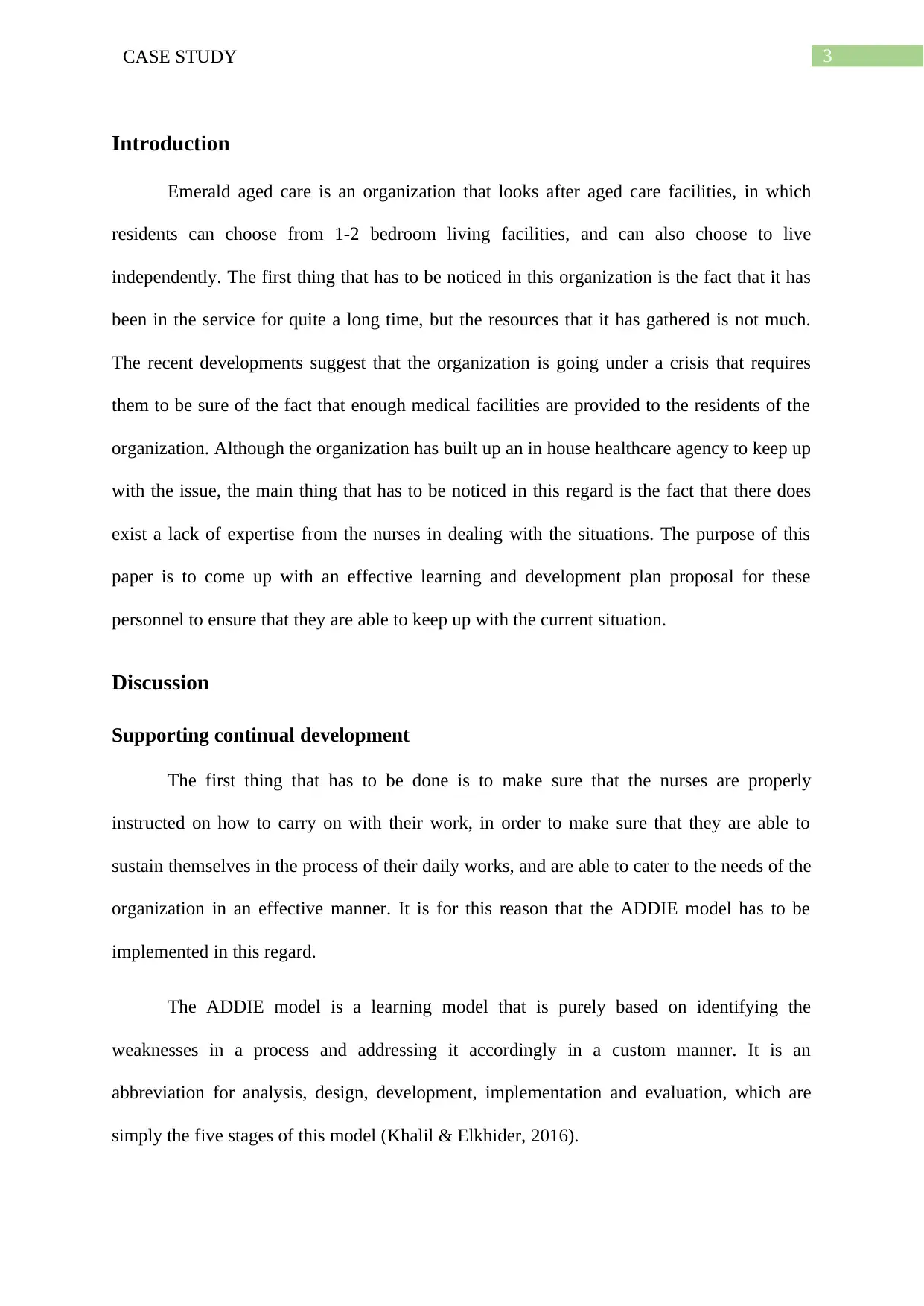
3CASE STUDY
Introduction
Emerald aged care is an organization that looks after aged care facilities, in which
residents can choose from 1-2 bedroom living facilities, and can also choose to live
independently. The first thing that has to be noticed in this organization is the fact that it has
been in the service for quite a long time, but the resources that it has gathered is not much.
The recent developments suggest that the organization is going under a crisis that requires
them to be sure of the fact that enough medical facilities are provided to the residents of the
organization. Although the organization has built up an in house healthcare agency to keep up
with the issue, the main thing that has to be noticed in this regard is the fact that there does
exist a lack of expertise from the nurses in dealing with the situations. The purpose of this
paper is to come up with an effective learning and development plan proposal for these
personnel to ensure that they are able to keep up with the current situation.
Discussion
Supporting continual development
The first thing that has to be done is to make sure that the nurses are properly
instructed on how to carry on with their work, in order to make sure that they are able to
sustain themselves in the process of their daily works, and are able to cater to the needs of the
organization in an effective manner. It is for this reason that the ADDIE model has to be
implemented in this regard.
The ADDIE model is a learning model that is purely based on identifying the
weaknesses in a process and addressing it accordingly in a custom manner. It is an
abbreviation for analysis, design, development, implementation and evaluation, which are
simply the five stages of this model (Khalil & Elkhider, 2016).
Introduction
Emerald aged care is an organization that looks after aged care facilities, in which
residents can choose from 1-2 bedroom living facilities, and can also choose to live
independently. The first thing that has to be noticed in this organization is the fact that it has
been in the service for quite a long time, but the resources that it has gathered is not much.
The recent developments suggest that the organization is going under a crisis that requires
them to be sure of the fact that enough medical facilities are provided to the residents of the
organization. Although the organization has built up an in house healthcare agency to keep up
with the issue, the main thing that has to be noticed in this regard is the fact that there does
exist a lack of expertise from the nurses in dealing with the situations. The purpose of this
paper is to come up with an effective learning and development plan proposal for these
personnel to ensure that they are able to keep up with the current situation.
Discussion
Supporting continual development
The first thing that has to be done is to make sure that the nurses are properly
instructed on how to carry on with their work, in order to make sure that they are able to
sustain themselves in the process of their daily works, and are able to cater to the needs of the
organization in an effective manner. It is for this reason that the ADDIE model has to be
implemented in this regard.
The ADDIE model is a learning model that is purely based on identifying the
weaknesses in a process and addressing it accordingly in a custom manner. It is an
abbreviation for analysis, design, development, implementation and evaluation, which are
simply the five stages of this model (Khalil & Elkhider, 2016).
Paraphrase This Document
Need a fresh take? Get an instant paraphrase of this document with our AI Paraphraser
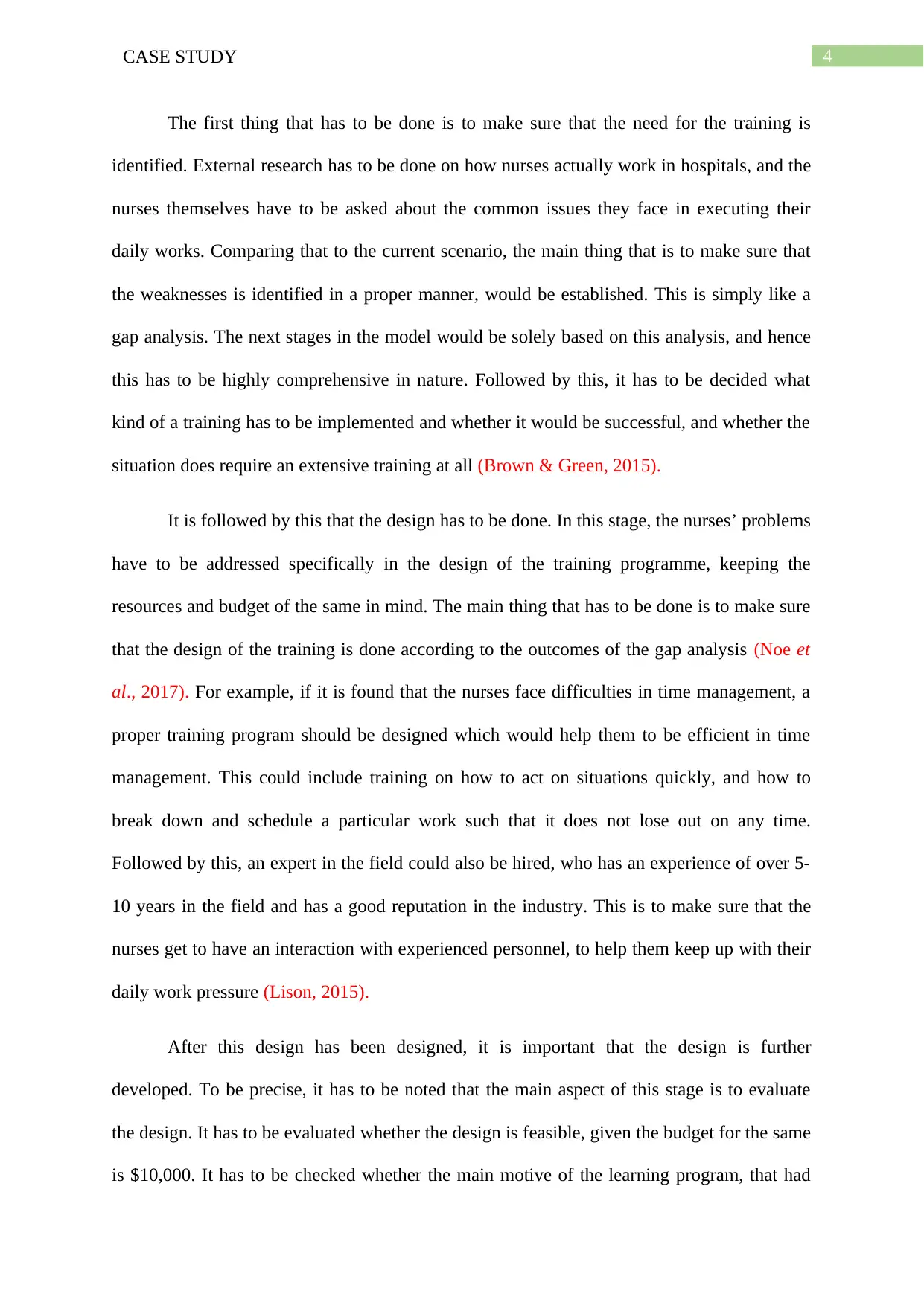
4CASE STUDY
The first thing that has to be done is to make sure that the need for the training is
identified. External research has to be done on how nurses actually work in hospitals, and the
nurses themselves have to be asked about the common issues they face in executing their
daily works. Comparing that to the current scenario, the main thing that is to make sure that
the weaknesses is identified in a proper manner, would be established. This is simply like a
gap analysis. The next stages in the model would be solely based on this analysis, and hence
this has to be highly comprehensive in nature. Followed by this, it has to be decided what
kind of a training has to be implemented and whether it would be successful, and whether the
situation does require an extensive training at all (Brown & Green, 2015).
It is followed by this that the design has to be done. In this stage, the nurses’ problems
have to be addressed specifically in the design of the training programme, keeping the
resources and budget of the same in mind. The main thing that has to be done is to make sure
that the design of the training is done according to the outcomes of the gap analysis (Noe et
al., 2017). For example, if it is found that the nurses face difficulties in time management, a
proper training program should be designed which would help them to be efficient in time
management. This could include training on how to act on situations quickly, and how to
break down and schedule a particular work such that it does not lose out on any time.
Followed by this, an expert in the field could also be hired, who has an experience of over 5-
10 years in the field and has a good reputation in the industry. This is to make sure that the
nurses get to have an interaction with experienced personnel, to help them keep up with their
daily work pressure (Lison, 2015).
After this design has been designed, it is important that the design is further
developed. To be precise, it has to be noted that the main aspect of this stage is to evaluate
the design. It has to be evaluated whether the design is feasible, given the budget for the same
is $10,000. It has to be checked whether the main motive of the learning program, that had
The first thing that has to be done is to make sure that the need for the training is
identified. External research has to be done on how nurses actually work in hospitals, and the
nurses themselves have to be asked about the common issues they face in executing their
daily works. Comparing that to the current scenario, the main thing that is to make sure that
the weaknesses is identified in a proper manner, would be established. This is simply like a
gap analysis. The next stages in the model would be solely based on this analysis, and hence
this has to be highly comprehensive in nature. Followed by this, it has to be decided what
kind of a training has to be implemented and whether it would be successful, and whether the
situation does require an extensive training at all (Brown & Green, 2015).
It is followed by this that the design has to be done. In this stage, the nurses’ problems
have to be addressed specifically in the design of the training programme, keeping the
resources and budget of the same in mind. The main thing that has to be done is to make sure
that the design of the training is done according to the outcomes of the gap analysis (Noe et
al., 2017). For example, if it is found that the nurses face difficulties in time management, a
proper training program should be designed which would help them to be efficient in time
management. This could include training on how to act on situations quickly, and how to
break down and schedule a particular work such that it does not lose out on any time.
Followed by this, an expert in the field could also be hired, who has an experience of over 5-
10 years in the field and has a good reputation in the industry. This is to make sure that the
nurses get to have an interaction with experienced personnel, to help them keep up with their
daily work pressure (Lison, 2015).
After this design has been designed, it is important that the design is further
developed. To be precise, it has to be noted that the main aspect of this stage is to evaluate
the design. It has to be evaluated whether the design is feasible, given the budget for the same
is $10,000. It has to be checked whether the main motive of the learning program, that had
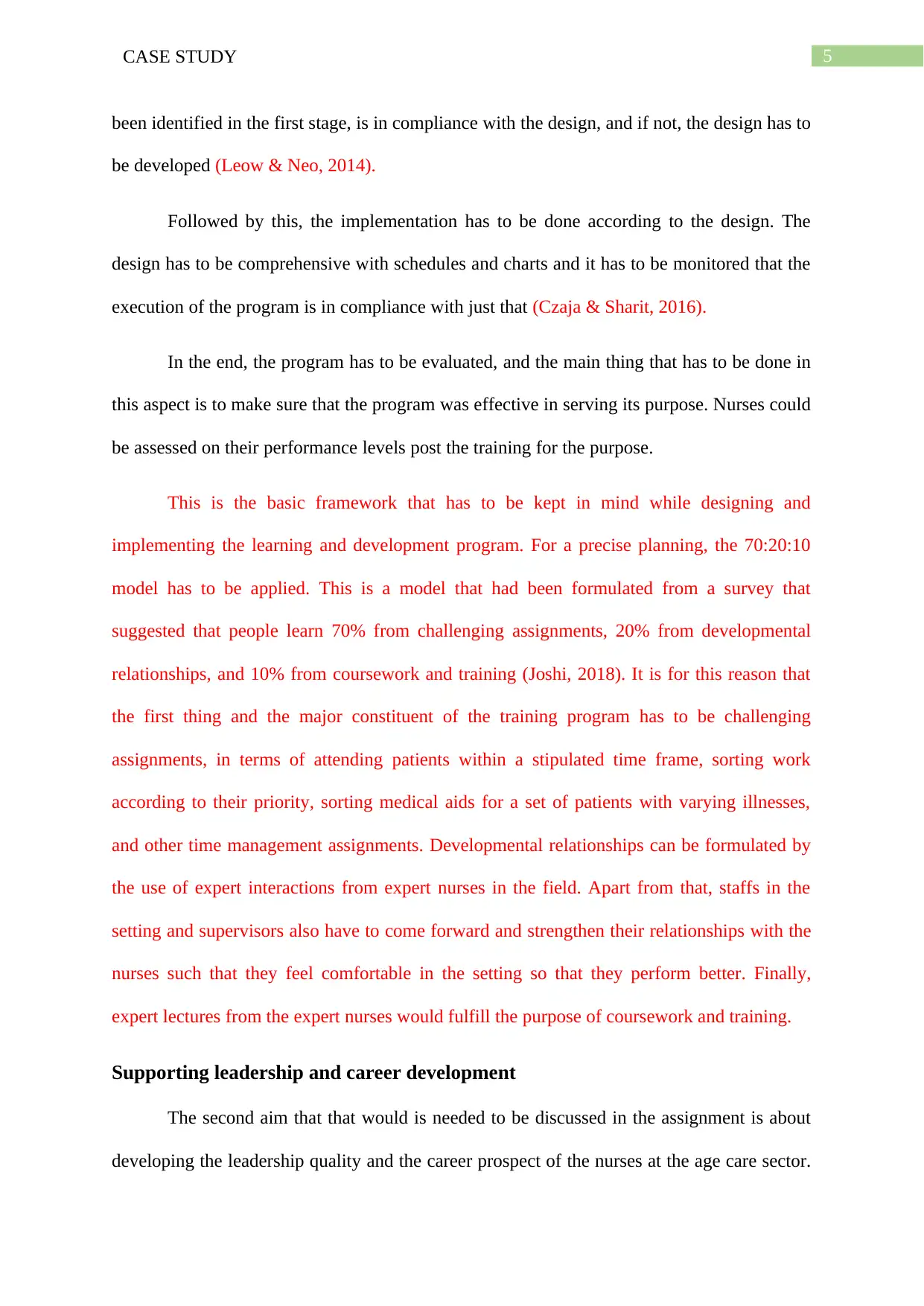
5CASE STUDY
been identified in the first stage, is in compliance with the design, and if not, the design has to
be developed (Leow & Neo, 2014).
Followed by this, the implementation has to be done according to the design. The
design has to be comprehensive with schedules and charts and it has to be monitored that the
execution of the program is in compliance with just that (Czaja & Sharit, 2016).
In the end, the program has to be evaluated, and the main thing that has to be done in
this aspect is to make sure that the program was effective in serving its purpose. Nurses could
be assessed on their performance levels post the training for the purpose.
This is the basic framework that has to be kept in mind while designing and
implementing the learning and development program. For a precise planning, the 70:20:10
model has to be applied. This is a model that had been formulated from a survey that
suggested that people learn 70% from challenging assignments, 20% from developmental
relationships, and 10% from coursework and training (Joshi, 2018). It is for this reason that
the first thing and the major constituent of the training program has to be challenging
assignments, in terms of attending patients within a stipulated time frame, sorting work
according to their priority, sorting medical aids for a set of patients with varying illnesses,
and other time management assignments. Developmental relationships can be formulated by
the use of expert interactions from expert nurses in the field. Apart from that, staffs in the
setting and supervisors also have to come forward and strengthen their relationships with the
nurses such that they feel comfortable in the setting so that they perform better. Finally,
expert lectures from the expert nurses would fulfill the purpose of coursework and training.
Supporting leadership and career development
The second aim that that would is needed to be discussed in the assignment is about
developing the leadership quality and the career prospect of the nurses at the age care sector.
been identified in the first stage, is in compliance with the design, and if not, the design has to
be developed (Leow & Neo, 2014).
Followed by this, the implementation has to be done according to the design. The
design has to be comprehensive with schedules and charts and it has to be monitored that the
execution of the program is in compliance with just that (Czaja & Sharit, 2016).
In the end, the program has to be evaluated, and the main thing that has to be done in
this aspect is to make sure that the program was effective in serving its purpose. Nurses could
be assessed on their performance levels post the training for the purpose.
This is the basic framework that has to be kept in mind while designing and
implementing the learning and development program. For a precise planning, the 70:20:10
model has to be applied. This is a model that had been formulated from a survey that
suggested that people learn 70% from challenging assignments, 20% from developmental
relationships, and 10% from coursework and training (Joshi, 2018). It is for this reason that
the first thing and the major constituent of the training program has to be challenging
assignments, in terms of attending patients within a stipulated time frame, sorting work
according to their priority, sorting medical aids for a set of patients with varying illnesses,
and other time management assignments. Developmental relationships can be formulated by
the use of expert interactions from expert nurses in the field. Apart from that, staffs in the
setting and supervisors also have to come forward and strengthen their relationships with the
nurses such that they feel comfortable in the setting so that they perform better. Finally,
expert lectures from the expert nurses would fulfill the purpose of coursework and training.
Supporting leadership and career development
The second aim that that would is needed to be discussed in the assignment is about
developing the leadership quality and the career prospect of the nurses at the age care sector.
⊘ This is a preview!⊘
Do you want full access?
Subscribe today to unlock all pages.

Trusted by 1+ million students worldwide
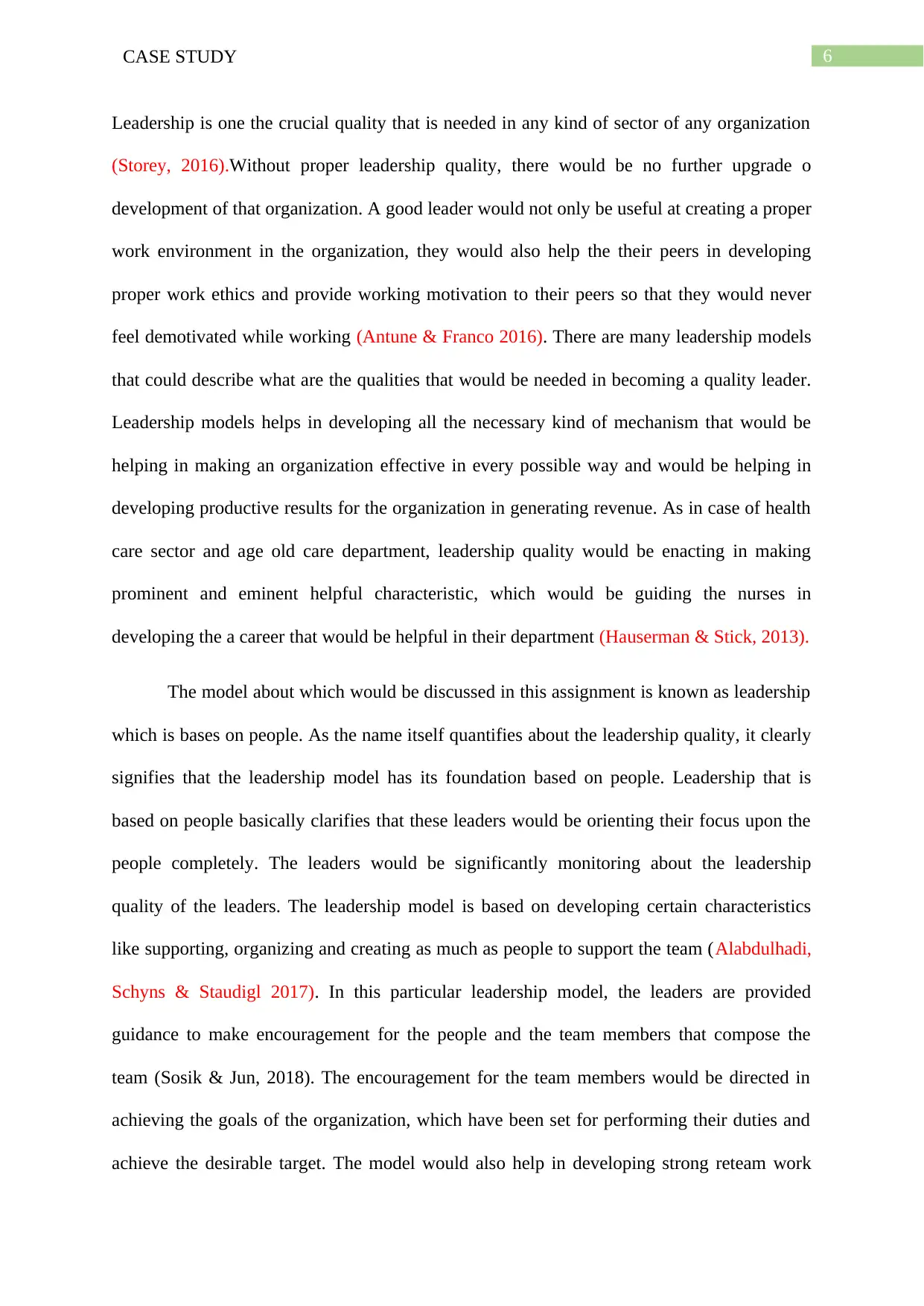
6CASE STUDY
Leadership is one the crucial quality that is needed in any kind of sector of any organization
(Storey, 2016).Without proper leadership quality, there would be no further upgrade o
development of that organization. A good leader would not only be useful at creating a proper
work environment in the organization, they would also help the their peers in developing
proper work ethics and provide working motivation to their peers so that they would never
feel demotivated while working (Antune & Franco 2016). There are many leadership models
that could describe what are the qualities that would be needed in becoming a quality leader.
Leadership models helps in developing all the necessary kind of mechanism that would be
helping in making an organization effective in every possible way and would be helping in
developing productive results for the organization in generating revenue. As in case of health
care sector and age old care department, leadership quality would be enacting in making
prominent and eminent helpful characteristic, which would be guiding the nurses in
developing the a career that would be helpful in their department (Hauserman & Stick, 2013).
The model about which would be discussed in this assignment is known as leadership
which is bases on people. As the name itself quantifies about the leadership quality, it clearly
signifies that the leadership model has its foundation based on people. Leadership that is
based on people basically clarifies that these leaders would be orienting their focus upon the
people completely. The leaders would be significantly monitoring about the leadership
quality of the leaders. The leadership model is based on developing certain characteristics
like supporting, organizing and creating as much as people to support the team (Alabdulhadi,
Schyns & Staudigl 2017). In this particular leadership model, the leaders are provided
guidance to make encouragement for the people and the team members that compose the
team (Sosik & Jun, 2018). The encouragement for the team members would be directed in
achieving the goals of the organization, which have been set for performing their duties and
achieve the desirable target. The model would also help in developing strong reteam work
Leadership is one the crucial quality that is needed in any kind of sector of any organization
(Storey, 2016).Without proper leadership quality, there would be no further upgrade o
development of that organization. A good leader would not only be useful at creating a proper
work environment in the organization, they would also help the their peers in developing
proper work ethics and provide working motivation to their peers so that they would never
feel demotivated while working (Antune & Franco 2016). There are many leadership models
that could describe what are the qualities that would be needed in becoming a quality leader.
Leadership models helps in developing all the necessary kind of mechanism that would be
helping in making an organization effective in every possible way and would be helping in
developing productive results for the organization in generating revenue. As in case of health
care sector and age old care department, leadership quality would be enacting in making
prominent and eminent helpful characteristic, which would be guiding the nurses in
developing the a career that would be helpful in their department (Hauserman & Stick, 2013).
The model about which would be discussed in this assignment is known as leadership
which is bases on people. As the name itself quantifies about the leadership quality, it clearly
signifies that the leadership model has its foundation based on people. Leadership that is
based on people basically clarifies that these leaders would be orienting their focus upon the
people completely. The leaders would be significantly monitoring about the leadership
quality of the leaders. The leadership model is based on developing certain characteristics
like supporting, organizing and creating as much as people to support the team (Alabdulhadi,
Schyns & Staudigl 2017). In this particular leadership model, the leaders are provided
guidance to make encouragement for the people and the team members that compose the
team (Sosik & Jun, 2018). The encouragement for the team members would be directed in
achieving the goals of the organization, which have been set for performing their duties and
achieve the desirable target. The model would also help in developing strong reteam work
Paraphrase This Document
Need a fresh take? Get an instant paraphrase of this document with our AI Paraphraser
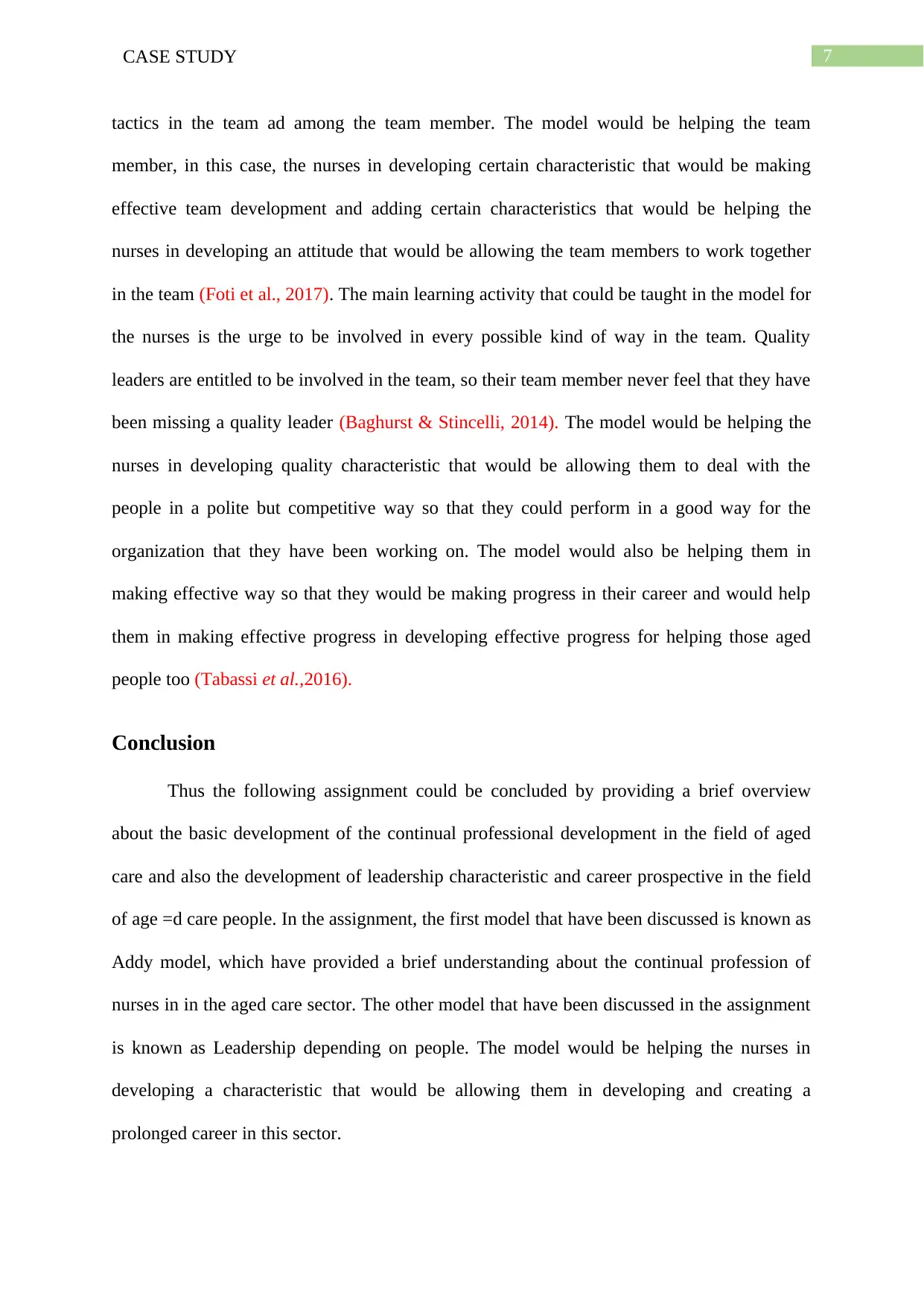
7CASE STUDY
tactics in the team ad among the team member. The model would be helping the team
member, in this case, the nurses in developing certain characteristic that would be making
effective team development and adding certain characteristics that would be helping the
nurses in developing an attitude that would be allowing the team members to work together
in the team (Foti et al., 2017). The main learning activity that could be taught in the model for
the nurses is the urge to be involved in every possible kind of way in the team. Quality
leaders are entitled to be involved in the team, so their team member never feel that they have
been missing a quality leader (Baghurst & Stincelli, 2014). The model would be helping the
nurses in developing quality characteristic that would be allowing them to deal with the
people in a polite but competitive way so that they could perform in a good way for the
organization that they have been working on. The model would also be helping them in
making effective way so that they would be making progress in their career and would help
them in making effective progress in developing effective progress for helping those aged
people too (Tabassi et al.,2016).
Conclusion
Thus the following assignment could be concluded by providing a brief overview
about the basic development of the continual professional development in the field of aged
care and also the development of leadership characteristic and career prospective in the field
of age =d care people. In the assignment, the first model that have been discussed is known as
Addy model, which have provided a brief understanding about the continual profession of
nurses in in the aged care sector. The other model that have been discussed in the assignment
is known as Leadership depending on people. The model would be helping the nurses in
developing a characteristic that would be allowing them in developing and creating a
prolonged career in this sector.
tactics in the team ad among the team member. The model would be helping the team
member, in this case, the nurses in developing certain characteristic that would be making
effective team development and adding certain characteristics that would be helping the
nurses in developing an attitude that would be allowing the team members to work together
in the team (Foti et al., 2017). The main learning activity that could be taught in the model for
the nurses is the urge to be involved in every possible kind of way in the team. Quality
leaders are entitled to be involved in the team, so their team member never feel that they have
been missing a quality leader (Baghurst & Stincelli, 2014). The model would be helping the
nurses in developing quality characteristic that would be allowing them to deal with the
people in a polite but competitive way so that they could perform in a good way for the
organization that they have been working on. The model would also be helping them in
making effective way so that they would be making progress in their career and would help
them in making effective progress in developing effective progress for helping those aged
people too (Tabassi et al.,2016).
Conclusion
Thus the following assignment could be concluded by providing a brief overview
about the basic development of the continual professional development in the field of aged
care and also the development of leadership characteristic and career prospective in the field
of age =d care people. In the assignment, the first model that have been discussed is known as
Addy model, which have provided a brief understanding about the continual profession of
nurses in in the aged care sector. The other model that have been discussed in the assignment
is known as Leadership depending on people. The model would be helping the nurses in
developing a characteristic that would be allowing them in developing and creating a
prolonged career in this sector.
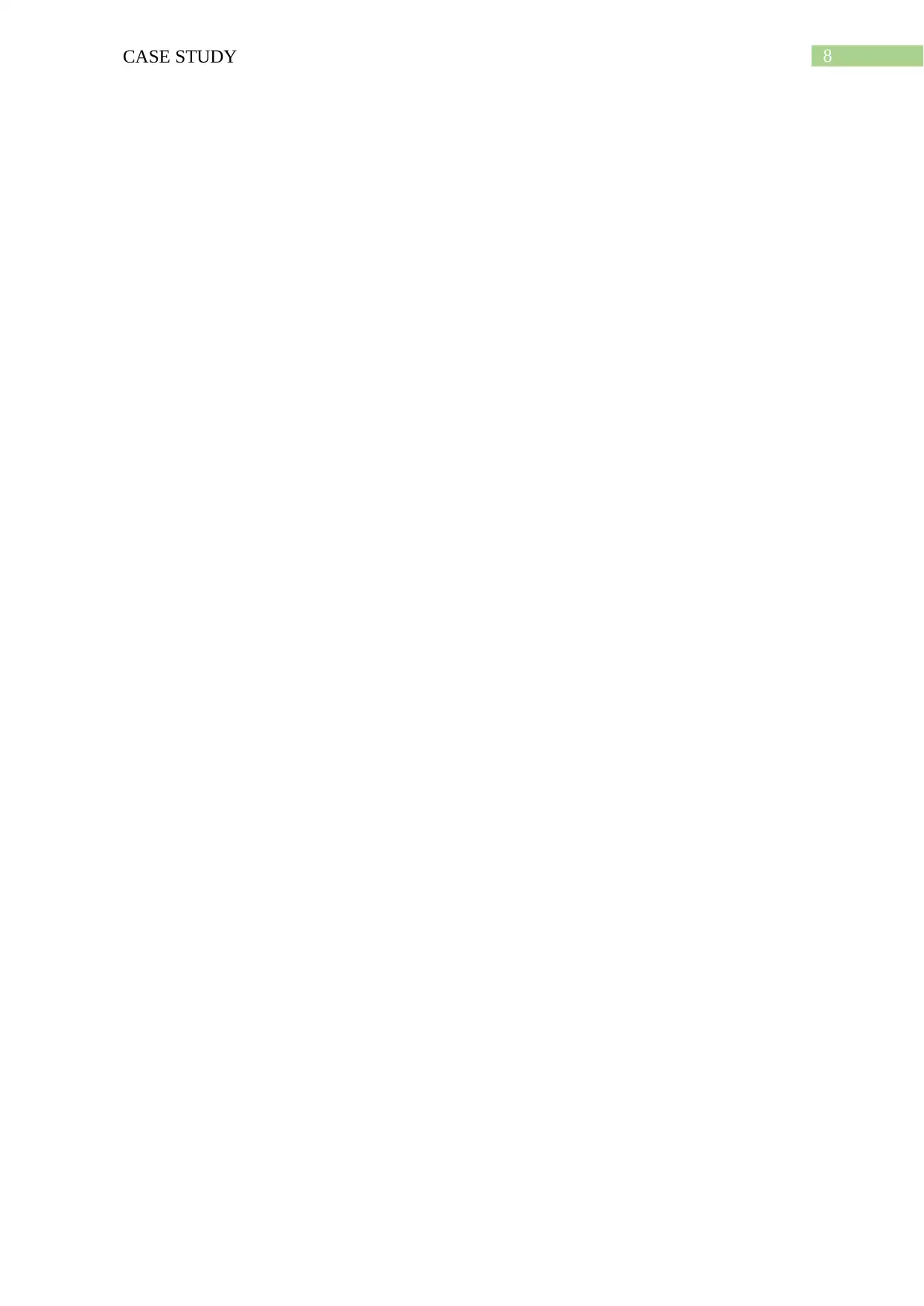
8CASE STUDY
⊘ This is a preview!⊘
Do you want full access?
Subscribe today to unlock all pages.

Trusted by 1+ million students worldwide
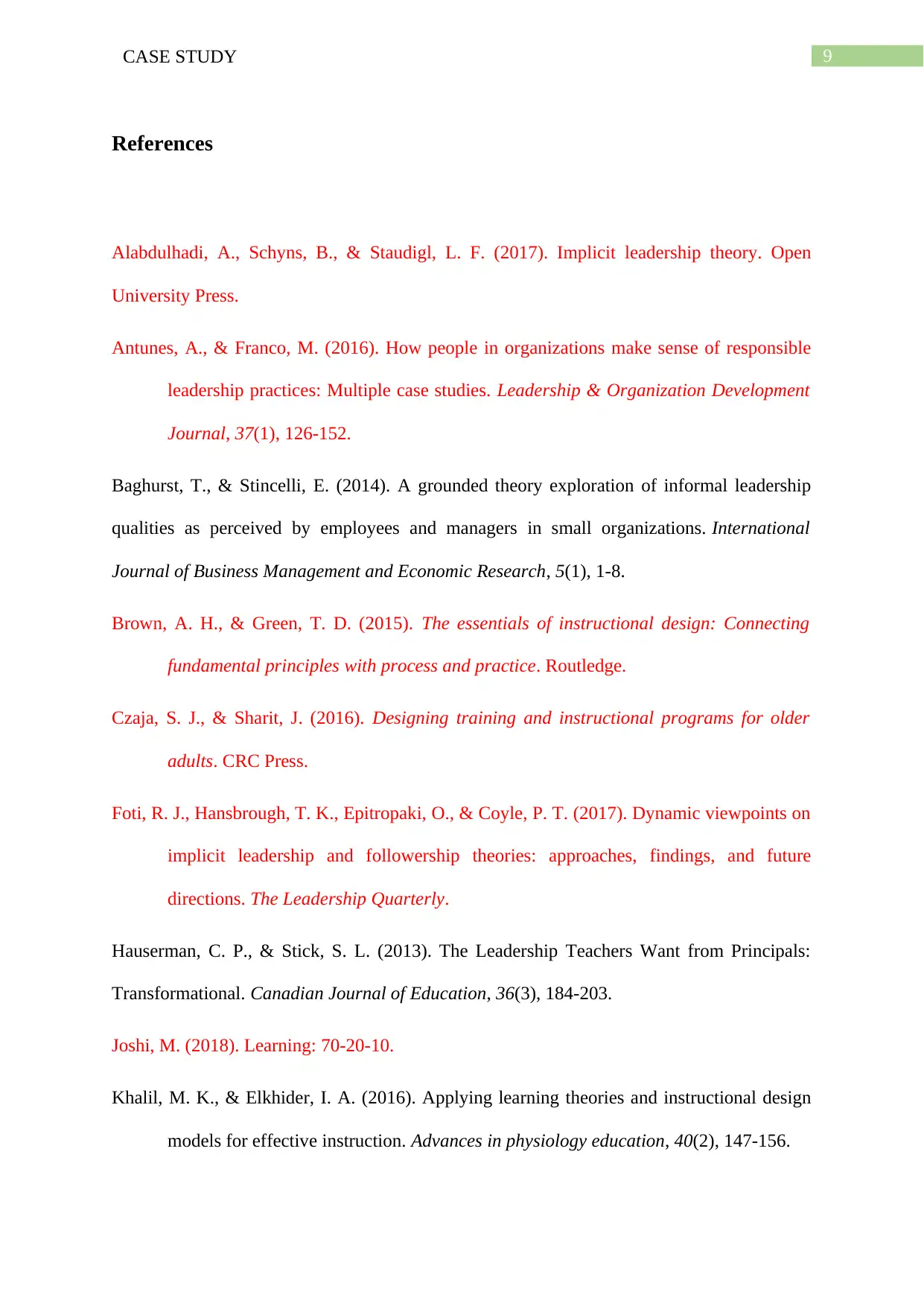
9CASE STUDY
References
Alabdulhadi, A., Schyns, B., & Staudigl, L. F. (2017). Implicit leadership theory. Open
University Press.
Antunes, A., & Franco, M. (2016). How people in organizations make sense of responsible
leadership practices: Multiple case studies. Leadership & Organization Development
Journal, 37(1), 126-152.
Baghurst, T., & Stincelli, E. (2014). A grounded theory exploration of informal leadership
qualities as perceived by employees and managers in small organizations. International
Journal of Business Management and Economic Research, 5(1), 1-8.
Brown, A. H., & Green, T. D. (2015). The essentials of instructional design: Connecting
fundamental principles with process and practice. Routledge.
Czaja, S. J., & Sharit, J. (2016). Designing training and instructional programs for older
adults. CRC Press.
Foti, R. J., Hansbrough, T. K., Epitropaki, O., & Coyle, P. T. (2017). Dynamic viewpoints on
implicit leadership and followership theories: approaches, findings, and future
directions. The Leadership Quarterly.
Hauserman, C. P., & Stick, S. L. (2013). The Leadership Teachers Want from Principals:
Transformational. Canadian Journal of Education, 36(3), 184-203.
Joshi, M. (2018). Learning: 70-20-10.
Khalil, M. K., & Elkhider, I. A. (2016). Applying learning theories and instructional design
models for effective instruction. Advances in physiology education, 40(2), 147-156.
References
Alabdulhadi, A., Schyns, B., & Staudigl, L. F. (2017). Implicit leadership theory. Open
University Press.
Antunes, A., & Franco, M. (2016). How people in organizations make sense of responsible
leadership practices: Multiple case studies. Leadership & Organization Development
Journal, 37(1), 126-152.
Baghurst, T., & Stincelli, E. (2014). A grounded theory exploration of informal leadership
qualities as perceived by employees and managers in small organizations. International
Journal of Business Management and Economic Research, 5(1), 1-8.
Brown, A. H., & Green, T. D. (2015). The essentials of instructional design: Connecting
fundamental principles with process and practice. Routledge.
Czaja, S. J., & Sharit, J. (2016). Designing training and instructional programs for older
adults. CRC Press.
Foti, R. J., Hansbrough, T. K., Epitropaki, O., & Coyle, P. T. (2017). Dynamic viewpoints on
implicit leadership and followership theories: approaches, findings, and future
directions. The Leadership Quarterly.
Hauserman, C. P., & Stick, S. L. (2013). The Leadership Teachers Want from Principals:
Transformational. Canadian Journal of Education, 36(3), 184-203.
Joshi, M. (2018). Learning: 70-20-10.
Khalil, M. K., & Elkhider, I. A. (2016). Applying learning theories and instructional design
models for effective instruction. Advances in physiology education, 40(2), 147-156.
Paraphrase This Document
Need a fresh take? Get an instant paraphrase of this document with our AI Paraphraser
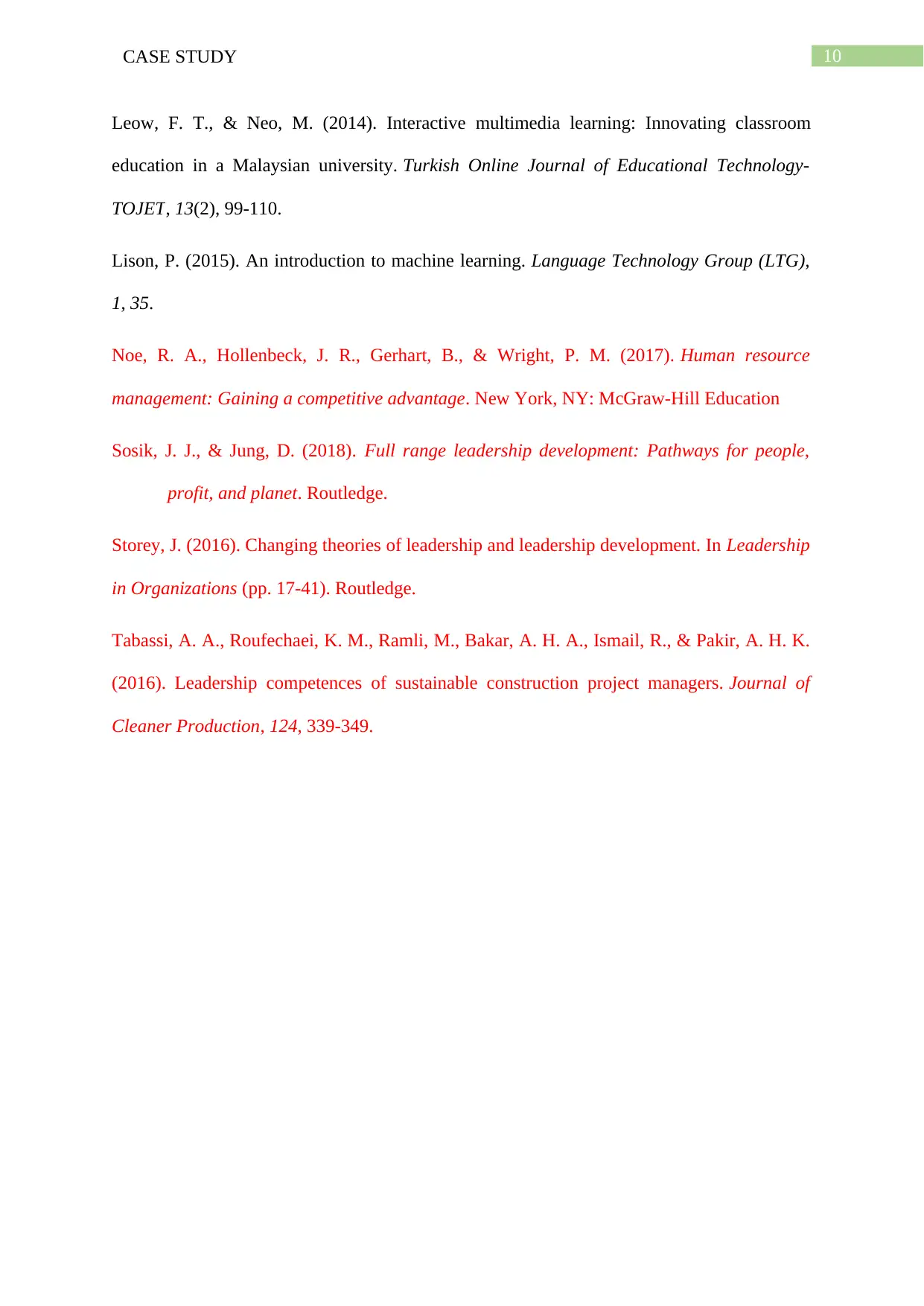
10CASE STUDY
Leow, F. T., & Neo, M. (2014). Interactive multimedia learning: Innovating classroom
education in a Malaysian university. Turkish Online Journal of Educational Technology-
TOJET, 13(2), 99-110.
Lison, P. (2015). An introduction to machine learning. Language Technology Group (LTG),
1, 35.
Noe, R. A., Hollenbeck, J. R., Gerhart, B., & Wright, P. M. (2017). Human resource
management: Gaining a competitive advantage. New York, NY: McGraw-Hill Education
Sosik, J. J., & Jung, D. (2018). Full range leadership development: Pathways for people,
profit, and planet. Routledge.
Storey, J. (2016). Changing theories of leadership and leadership development. In Leadership
in Organizations (pp. 17-41). Routledge.
Tabassi, A. A., Roufechaei, K. M., Ramli, M., Bakar, A. H. A., Ismail, R., & Pakir, A. H. K.
(2016). Leadership competences of sustainable construction project managers. Journal of
Cleaner Production, 124, 339-349.
Leow, F. T., & Neo, M. (2014). Interactive multimedia learning: Innovating classroom
education in a Malaysian university. Turkish Online Journal of Educational Technology-
TOJET, 13(2), 99-110.
Lison, P. (2015). An introduction to machine learning. Language Technology Group (LTG),
1, 35.
Noe, R. A., Hollenbeck, J. R., Gerhart, B., & Wright, P. M. (2017). Human resource
management: Gaining a competitive advantage. New York, NY: McGraw-Hill Education
Sosik, J. J., & Jung, D. (2018). Full range leadership development: Pathways for people,
profit, and planet. Routledge.
Storey, J. (2016). Changing theories of leadership and leadership development. In Leadership
in Organizations (pp. 17-41). Routledge.
Tabassi, A. A., Roufechaei, K. M., Ramli, M., Bakar, A. H. A., Ismail, R., & Pakir, A. H. K.
(2016). Leadership competences of sustainable construction project managers. Journal of
Cleaner Production, 124, 339-349.
1 out of 11
Related Documents
Your All-in-One AI-Powered Toolkit for Academic Success.
+13062052269
info@desklib.com
Available 24*7 on WhatsApp / Email
![[object Object]](/_next/static/media/star-bottom.7253800d.svg)
Unlock your academic potential
Copyright © 2020–2025 A2Z Services. All Rights Reserved. Developed and managed by ZUCOL.





